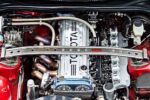Chevy 5.7 Vortec Engine: A Brief Overview
History and Development
The Chevy 5.7 Vortec engine, also known as the 350 small-block, has been a staple in General Motors’ lineup since its introduction in the 1950s. Over the decades, this engine has undergone numerous iterations and improvements, becoming one of the most recognized and widely used engines in the automotive industry. The Vortec designation was introduced in the 1990s, signifying advancements in engine technology, including improved airflow and fuel efficiency. This engine found its way into a variety of vehicles, from trucks and SUVs to performance cars, making it a versatile choice for many applications.
The 5.7 Vortec engine gained popularity for its robust performance and reliability. It was particularly favored in the Chevrolet Silverado and GMC Sierra trucks, where it provided the necessary power for towing and hauling. The engine’s design allowed for easy modifications, making it a favorite among automotive enthusiasts who sought to enhance performance. However, despite its many strengths, the 5.7 Vortec engine is not without its issues. Over the years, owners have reported a range of problems that can affect performance, reliability, and overall vehicle safety.
As we delve into the common problems associated with the Chevy 5.7 Vortec engine, it becomes clear that understanding these issues is crucial for current and prospective owners. Whether you’re a long-time fan of the small-block or considering a purchase, being informed about the potential pitfalls can save you time, money, and frustration down the road.
Common Issues with the Chevy 5.7 Vortec Engine
The Chevy 5.7 Vortec engine, while celebrated for its performance and versatility, is not without its share of problems. Understanding these issues is vital for any owner or potential buyer. Below are some of the most common problems associated with this engine, along with their symptoms and potential consequences.
1. Intake Manifold Gasket Failure
One of the most notorious issues with the 5.7 Vortec engine is the failure of the intake manifold gasket. This problem can lead to coolant leaks and engine overheating.
Symptoms:
– Coolant loss without visible leaks
– Engine overheating
– White smoke from the exhaust
Consequences:
– Engine damage due to overheating
– Increased repair costs
2. Fuel Injector Problems
Fuel injectors can become clogged or fail over time, leading to poor engine performance and fuel efficiency.
Symptoms:
– Rough idling
– Decreased fuel economy
– Engine misfires
Consequences:
– Potential engine damage if not addressed
– Increased emissions
3. Oil Consumption Issues
Many owners report excessive oil consumption in the 5.7 Vortec engine, which can be attributed to worn piston rings or valve seals.
Symptoms:
– Frequent oil top-ups
– Blue smoke from the exhaust
– Oil leaks around the engine
Consequences:
– Engine wear and tear
– Risk of engine failure if oil levels are not maintained
4. Timing Chain Tensioner Failure
The timing chain tensioner can wear out, leading to timing issues that affect engine performance.
Symptoms:
– Rattling noise from the engine
– Poor acceleration
– Check engine light activation
Consequences:
– Severe engine damage if the timing chain fails
– Expensive repairs
5. Overheating Issues
Overheating can be caused by various factors, including coolant leaks, a failing water pump, or a clogged radiator.
Symptoms:
– Temperature gauge reading high
– Steam coming from the engine
– Engine warning lights
Consequences:
– Potential engine failure
– Costly repairs due to overheating damage
6. Electrical Problems
Electrical issues, such as faulty sensors or wiring, can lead to various performance problems.
Symptoms:
– Erratic engine performance
– Dashboard warning lights
– Difficulty starting the engine
Consequences:
– Increased diagnostic and repair costs
– Potential safety hazards while driving
Top views |
|
|---|---|
 |
Oil, Timing Chains, Pistons: What Really Kills an Engine Prematurely? |
 |
How to Choose a Car with a Reliable Engine: Used Car Market Hacks That Actually Work |
Symptoms and Consequences Table
| Problem | Symptoms | Consequences |
|---|---|---|
| Intake Manifold Gasket Failure | Coolant loss, engine overheating, white smoke | Engine damage, increased repair costs |
| Fuel Injector Problems | Rough idling, decreased fuel economy, engine misfires | Potential engine damage, increased emissions |
| Oil Consumption Issues | Frequent oil top-ups, blue smoke, oil leaks | Engine wear, risk of engine failure |
| Timing Chain Tensioner Failure | Rattling noise, poor acceleration, check engine light | Severe engine damage, expensive repairs |
| Overheating Issues | High temperature gauge, steam, warning lights | Potential engine failure, costly repairs |
| Electrical Problems | Erratic performance, warning lights, starting issues | Increased diagnostic costs, safety hazards |




0 Comments